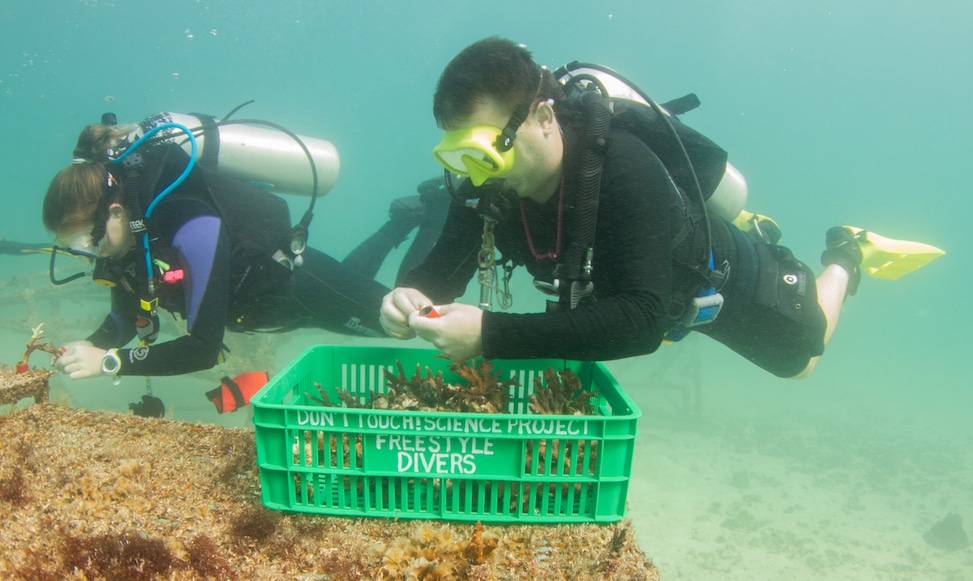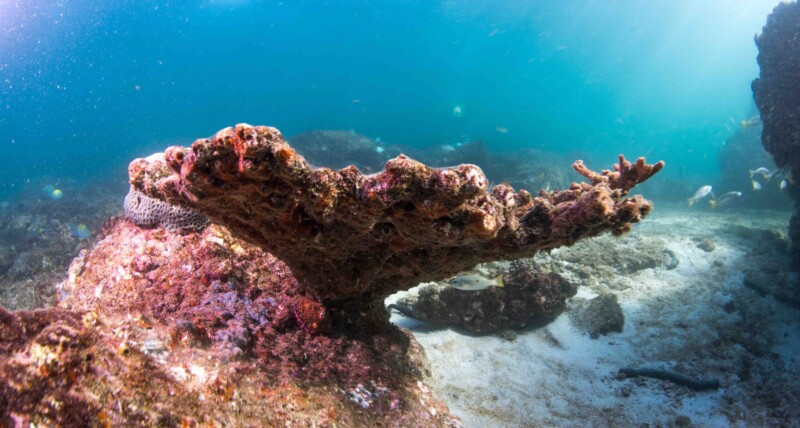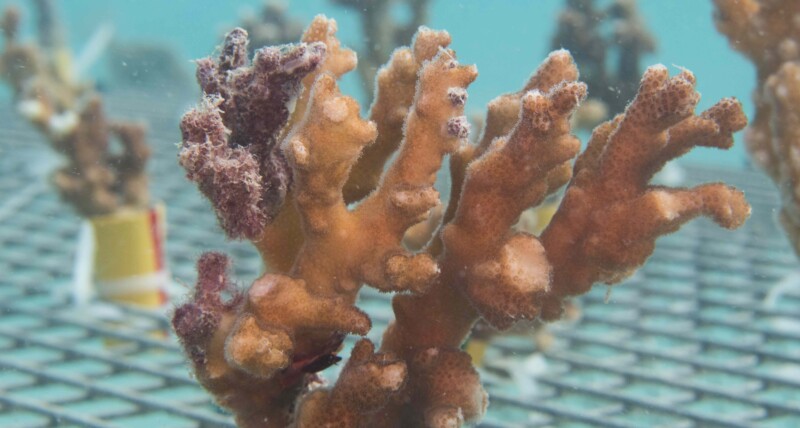January – March 2022

Introduction
First and foremost, thank you to all the sponsors who have contributed to this project to help protect the coral reef ecosystems on the East coast of the UAE. The artificial reef is ever expanding, with more reef sponsorships coming through almost weekly at this point. Importantly, with the number of new reefs and nursery tables that have been ordered, the need for trained coral conservationists has also increased. The scholarship funding contributions from some sponsors is helping us to reach those goals, however we will need to continue to increase the size of the team, and funding of education and training remains an ongoing focus.
What happens during the Winter months?
The winter months are always the slowest months for productivity of the reefs, primarily due to reduced water temperatures and high turbidity of the water. The reduced water temperatures are naturally occurring with a temperature averaging around 23 degrees Celsius over these months, compared to an average of 32 degrees Celsius over the summer months. The high turbidity causes reduced water clarity, which means less light can reach the coral and therefore the symbiont algae will have reduced photosynthesis, providing less food for the coral itself. This increased turbidity is due to the winter storm season, with increased wind and waves as well as colder water sinking into the depths, creating upwellings of nutrient rich turbid water. These nutrient rich waters are brilliant for marine life overall, plankton blooms occur due to the availability of limiting nutrients, which means that the bio productivity of the area goes through the roof and large pelagic creatures such as whales come inshore to feed.
The effects of nutrients on coral
Corals don’t like these nutrients – they are self-sufficient and the coral’s symbiotic relationship with the algae within them provides all the nutrients the algae need, which is why coral is dominant in the crystal clear azure waters we normally associate with coral reefs. Too many nutrients for a prolonged period, either due to changing weather cycles or run off from anthropogenic (human produced) sources can lead to an algal phase shift, whereby macro algae becomes dominant on a reef killing all the coral cause the biodiversity of the area to plummet.
Among other benefits, the construction of artificial reefs is an effective approach to preventing algal phase shifts. As we increase the collective coral population it becomes larger, and therefore stronger and more resilient to this nutrification. Correct placement of the reefs means that the coral is in the optimal environment, so that increased turbidity has less of an impact on the coral. Healthy coral easily outcompetes external algae, stressed coral struggles to combat the invasion.
The artificial reefs themselves also provides habitat, specifically in this case for herbivores which eat the algae, so more habitat means more fish, more herbivores and less algae, promoting coral dominance. This is just two of the direct ways in which the artificial reef our sponsors have helped create are contributing towards conserving a healthy coral reef ecosystem in this region.
Continued expansion of the reef
We have installed the following structures onto the site to date:
- 9 nursery tables, collectively sponsored by DITH MENA, IDS, and Freestyle Divers.
- One Dibba Bay nursery table with a new design that includes oyster shells.
- The ASRAQ and Freestyle Divers Shark reef.
- The X-press Feeders whaleshark reef.
- The Firetti Contemporary Gallery turtle reef.
- The AA turtle reef.
- The Upfill. UAE map and logo reef.
- The Scotch & Soda logo reef.
- The Dubai 92 logo reef.
- The Dubai 92 competition winner sting ray reef.
- The Dell dome logo reef.
- The DITH MENA Octopus, tribulus flower, sting ray and turtle reefs.
- The Maersk turtle reef.
- Three Ounas logo table reefs
- The Guinness Book of Records logo reef
We have been fortunate to acquire new orders from sponsors including Mubadala Petroleum and Mandarin Oriental Jumeirah, which will add 5 more nursery tables and 19 more reef structures, and we are in the process of completing significant agreements with several other new sponsors.
Coral Propagation and Colonisation of the Artificial Reef
Planting of coral fragments has been reduced during the slow-growth Winter season, due to the rougher sea conditions as well as the water temperature and turbidity described above, nevertheless we have been able to increase the Acropora Sp. coral fragments on the nursery tables by 300 pieces, these were sourced from naturally broken fragments recovered from the seafloor in the Dibba Rock Marine Protected Area. These coral fragments will start growing faster as the water temperatures rise during the second quarter of the year.
We also experienced some violent storms during the winter that led to some coral mortality, this is a natural process and part of the intermediate disturbance that serves as a driver for biodiversity on a coral reef ecosystem.
Intermediate disturbance – why a little bit of destruction is good
Intermediate Disturbance hypothesis is the theory behind the cause of biodiversity upon a coral reef. Low levels of disturbance would lead to one or few species dominating the ecosystem, thus reducing biodiversity. High levels of disturbance would mean that only a few very robust species would survive, again, decreasing the biodiversity of the ecosystem. Intermediate disturbance means that competition niche variability and the array of symbiotic relationships drives biodiversity of the coral reef ecosystem. The high biodiversity of a coral reef ecosystem signals that it is a healthy, thriving environment. So, in layman’s terms, storms breaking corals is one of Nature’s ways of forcing the reef to adapt and create a stronger, more resistant ecosystem.
Species observed on the artificial reef site
We started the new site in July 2021 on a barren, sandy bottom with very little established life. In the first quarter of 2022, we observed a range of life that has now migrated and calls the site home, as well as number of different transitory species passing through.
Highlights of the species observed include:
- Guitar Shark
- Green Turtle
- Hawksbill Turtle
- A large school of Longfin Batfish
- Arabian Box fish
- Chromadoris sp. nudibranch
- Schools of Golden Trevally
- Schools of Long Spot Dory Snapper
- Copious amounts of fish fry
- Damsel Fish
- Juvenile Emperor Angelfish
- Juvenile Arabian Angelfish
- Blue Streaked Cleaner Wrasse
- Starry Toadfish
- A variety of crustaceans including Hermit Crabs, Porcelain Crabs, Durban Dancing Shrimp, Coral Shrimp, Banded Coral Shrimp.
Summary
Collectively, the report shows that the reef is starting to establish itself as a habitat for marine life after initial acclimatisation during the winter months and that the structures are integrating into the local area as permanent fixtures. The presence of the herbivores will reduce the algal growth on the structures promoting coral dominance. Smaller predatory fish will reduce the number of pests that would hinder coral growth such as sponges and drupella snails.
Collectively a biodiverse ecosystem is forming, we have laid the foundations and now that Spring is here, we can increase coral planting to build on these foundations.
The process of colonization is underway and to measure it scientifically we will be monitoring a list of indicator species to determine the maturity of the developing ecosystem, this will be the subject of our next report.


